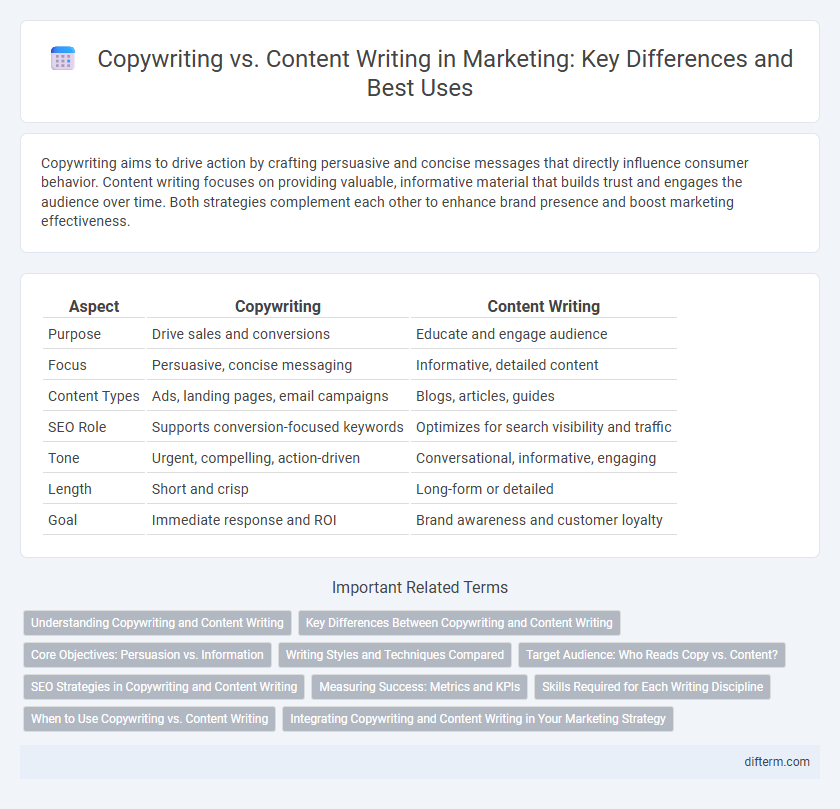Copywriting aims to drive action by crafting persuasive and concise messages that directly influence consumer behavior. Content writing focuses on providing valuable, informative material that builds trust and engages the audience over time. Both strategies complement each other to enhance brand presence and boost marketing effectiveness.
Table of Comparison
| Aspect | Copywriting | Content Writing |
|---|---|---|
| Purpose | Drive sales and conversions | Educate and engage audience |
| Focus | Persuasive, concise messaging | Informative, detailed content |
| Content Types | Ads, landing pages, email campaigns | Blogs, articles, guides |
| SEO Role | Supports conversion-focused keywords | Optimizes for search visibility and traffic |
| Tone | Urgent, compelling, action-driven | Conversational, informative, engaging |
| Length | Short and crisp | Long-form or detailed |
| Goal | Immediate response and ROI | Brand awareness and customer loyalty |
Understanding Copywriting and Content Writing
Copywriting aims to persuade audiences through concise, impactful messaging that drives specific actions like purchases or sign-ups, emphasizing conversion rates and direct response metrics. Content writing focuses on creating informative, engaging, and relevant material such as blog posts, articles, or guides to build brand authority and nurture long-term customer relationships. Both disciplines require strong storytelling skills, but copywriting prioritizes sales-driven language, whereas content writing emphasizes value-driven information.
Key Differences Between Copywriting and Content Writing
Copywriting targets persuasion by crafting concise, compelling messages aimed at driving immediate action, such as sales or sign-ups, often using emotional triggers and calls to action. Content writing focuses on creating informative, valuable, and engaging materials like blog posts, articles, or guides designed to educate or entertain the audience while building brand authority over time. Key differences include the intent, with copywriting prioritizing conversion rates and content writing emphasizing sustained audience engagement and SEO optimization.
Core Objectives: Persuasion vs. Information
Copywriting centers on persuasion, aiming to drive conversions and prompt immediate audience action through compelling calls-to-action and emotionally engaging language. Content writing prioritizes delivering valuable, informative content designed to educate, build trust, and nurture long-term relationships with the audience. Understanding these core objectives helps marketers tailor their strategies to either increase sales or enhance brand authority effectively.
Writing Styles and Techniques Compared
Copywriting utilizes persuasive and concise language focused on driving immediate action, incorporating techniques such as calls-to-action, emotional triggers, and value propositions. Content writing emphasizes informative and engaging storytelling aimed at building trust and long-term audience relationships using techniques like SEO optimization, detailed research, and educational tone. Both styles tailor language to target audiences, but copywriting prioritizes conversion rates while content writing focuses on audience retention and brand authority.
Target Audience: Who Reads Copy vs. Content?
Copywriting targets potential customers in the decision-making stage, aiming to drive immediate action through persuasive, concise messaging. Content writing attracts a broader audience seeking valuable information, education, and engagement, often nurturing long-term relationships. Understanding the differences in audience intent allows marketers to tailor strategies that enhance conversion rates and brand loyalty effectively.
SEO Strategies in Copywriting and Content Writing
Copywriting emphasizes persuasive language and targeted calls-to-action to boost conversion rates, while content writing focuses on delivering valuable, informative content to engage audiences and improve site authority. SEO strategies in copywriting involve optimizing meta tags, headlines, and keyword-rich calls-to-action to increase click-through rates and search rankings. Content writing SEO tactics prioritize long-tail keywords, informative structure, and internal linking to enhance organic traffic and retain visitor interest.
Measuring Success: Metrics and KPIs
Measuring success in copywriting primarily involves tracking conversion rates, click-through rates (CTR), and return on investment (ROI) as key performance indicators (KPIs) that directly reflect the effectiveness of persuasive messaging. In contrast, content writing success is often assessed through metrics such as organic traffic, average session duration, bounce rate, and social shares, which indicate audience engagement and content relevance. Both copywriting and content writing require analyzing user behavior data and A/B testing results to optimize strategies aligned with marketing goals.
Skills Required for Each Writing Discipline
Copywriting demands persuasive language skills, a deep understanding of consumer psychology, and the ability to craft compelling calls to action that drive conversions. Content writing requires strong research capabilities, SEO knowledge, and the ability to produce informative, engaging material that builds brand authority over time. Both disciplines benefit from excellent grammar and adaptability, but the focus of copywriting is conversion-oriented while content writing prioritizes value-driven audience engagement.
When to Use Copywriting vs. Content Writing
Copywriting is essential when the goal is to drive immediate action, such as boosting sales, generating leads, or promoting a product through persuasive and concise messaging. Content writing excels in building brand authority, educating the audience, and improving SEO by providing valuable, informative articles, blog posts, or guides. Marketers should use copywriting for sales funnels and advertisements, while content writing suits long-term engagement and relationship-building strategies.
Integrating Copywriting and Content Writing in Your Marketing Strategy
Integrating copywriting and content writing in your marketing strategy enhances brand messaging by combining persuasive calls-to-action with informative, value-driven content that engages your target audience. Copywriting drives conversions through concise, impactful language tailored to specific campaigns, while content writing builds trust and authority by delivering in-depth information and storytelling that nurture customer relationships. Aligning both approaches ensures a cohesive narrative that optimizes SEO, increases engagement, and maximizes ROI across multiple digital channels.
Copywriting vs Content Writing Infographic

 difterm.com
difterm.com